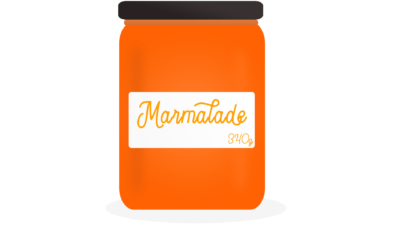Marmalade (Large)
Here you can choose from a variety of yummy, homemade marmalades made with a variety of citrus fruits – from the traditional Seville Orange to more experimental flavours like Lemon & Gin. Marmalade is a staple in most people’s food cupboards because of its simplicity and tastiness – it is popular on toast in the mornings with a cup of tea, but is almost super mixed with plain yoghurt or when used as a cake filling. Our personal favourite is a big dollop of marmalade in your porridge! Add a bit of variety to your mornings and try our Lime & Ginger marmalade – a great combination which you are very unlikely to find in the shops.
340g.
£4.50
The word “marmalade” stems from the Portuguese word marmelada, which in turn comes from marmelo or ‘quince’. Historically marmalade was made using quinces but as its popularity grew Seville oranges became the more popular ingredient firstly because they are significantly cheaper and more readily available than quinces, and also because they have a much higher natural pectin content leading to a well-set marmalade. Marmalade differs from jam because it is made using fruit peel as opposed to just the flesh and juice of fruit, also it traditionally is made specifically with citrus fruits .
There are several stories trying to explain the origin of the marmalade. In one of them, Mary Queen of Scots, fell ill and her doctor recommended an sweet orange potion as a remedy. The name marmalade came about when one of her maids whispered ‘Marie est malade’. (Mary is ill). However, most people consider this story a myth. Most likely marmalade made using quince began with the ancient Greeks who slow-cooked quinces with honey until it set. Modern orange marmalade first appears in a seventeenth century English cookery book and was designed to be eaten in the evening as an after-dinner treat. However it is the Scots who are credited with converting it into the breakfast spread we know today!
Marmalade is also a great source of vitamin C for your diet and is low in sodium, contains no fat and is lower in calories than many jams. With one teaspoon of marmalade containing around fifty calories, it is a healthy option for your breakfast table whether you are in a rush in the morning or not – always consider marmalade on toast.


